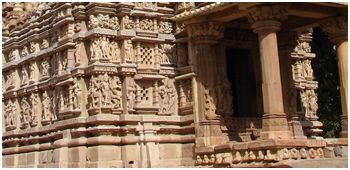
Located on the outskirts of the Kajuraho town, Ajaigarh Fort shows the architectural talents of the Chandela Kings. History says that this impressive fortress was built by them when their power in the area was declining. Ajaigarh Fort stands at an altitude of 1,111 meters on a flat-topped projection of the majestic Vindhyas. A large isolated hilltop fort, Ajaigarh fort holds the panoramic view of the beautiful Ken River. This massive structure was constructed to give protection to the local population from attacks and sieges of outsiders.
Kalinjar Fort
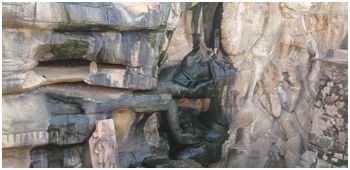
A hub of classic monuments and sculptures, the Kalinjar Fort has a magnificient history. This colossal fortress contains numerous temples and structures within it, which replicate the creative expertise of the Chandela dynasty. Like all other forts, this massive fort also is built for the purpose of defending the kingdom.This magnificient fort situates on the top of a holy hill, which has found its mention in many Hindu scriptures. The fort’s strategic location on the rocky terrain, coupled with its strong battlements interspersed with highly fortified gates gave it an awesome look. The palaces, temples, chhatris and other structures of the fort are constructed in the Hindu style of architecture. A unique monument of its time, the fort presents an unparallel dignity, elegance and artistry.
Adinath Temple
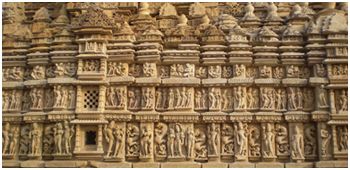
A sumptuously decorated temple with beautiful sculptures, Adinath Temple is dedicated to the Jain saint, Adinath. Believed to be built in the 11th century, this temple is an important constituent ... (more) A sumptuously decorated temple with beautiful sculptures, Adinath Temple is dedicated to the Jain saint, Adinath. Believed to be built in the 11th century, this temple is an important constituent of the Jain group of temples. The walls are adorned with beautifully carved figures of court musicians. Though the temple had not been restored to its former shape, some sort of renovations helped to maintain its former glory. Only the sanctum and vestibule of the old shrine has been survived the beatings of time. A modern entrance chamber, made of lime-plastered masonry, showing arched doorways, replaces its ‘mandapa’ and entrance porch. The temple is constructed in the form of 'sapta-ratha', and its single towered 'shikhara' gives the shrine a graceful look.
Brahma Temple
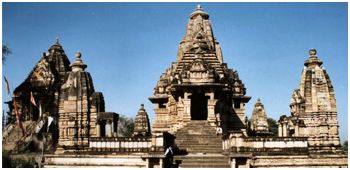
Built in 900, Brahma Temple is situated on the banks of the Ninora Tal, the largest tank in Khajuraho. It contains the images of Lord Brahma and Lord Vishnu. A small square shaped shrine, Brahma Temple rests on twelve pillars of granite at an elevation of 11 feet high platform. The lofty roof, which is a characteristic phenomenon of Khajuraho temples, is made up of sandstone. The temple in its entirety presents a granite formation. Each side of the temple shows prominent projections, which gives a wonderful charm to the shrine. In short Brahma temple displays the architectural brilliance of the medieval artists in its superb form.
Chausath Yogini Temple
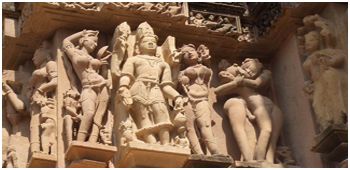
The oldest temple in Khajuraho, Chausath Yogini Temple is dedicated to the 64 yoginis who are the materialization of the Mother Goddess Shakti. Believed to be a 9th century monument, this temple is in a dilapidated state and the public access is restricted in this area. Small shrines dedicated to the goddess are raised on a massive platform, which are bounded by an open courtyard. This cluster of shrines, which are made up of granite, belongs to the Western group of temples.
Chitragupta Temple
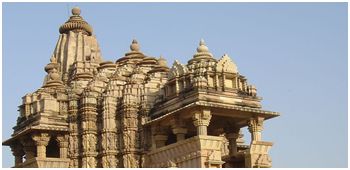
An ancient shrine, dedicated to Lord Surya, Chitragupta Temple faces eastwards to the rising sun. A 11th century old monument this temple enshrines an impressive 5 ft high image of Lord Surya in a standing posture driving a chariot of seven horses. Fabulously carved walls, which depicts voluptuous and full figured sura-sundaris, erotic couples, image of lord Vishnu in the 11 headed form, Chitragupta Temple really provides a rare feast to the viewer. The lintel of the intricate doorway portrays three similar but smaller figures of Lord Surya as depicted in the main sanctum. A temple with well ornate and developed features, the Chitragupta Temple houses an ancient three-storied stepped tank, known as ‘Chopra’, which is also a worth visiting spectacle.
Devi Jagdamba Temple
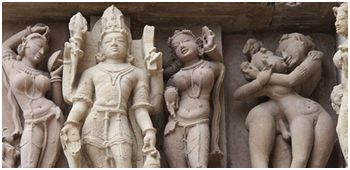
Devi Jagdambi Temple is famed for its erotic and intensely carved figures. A smaller and delicately balanced temple is bedecked with some of the premium figurines at Khajuraho. The Garbha Griha of this superb shrine houses a huge image of the goddess of the Universe. The temple also displays a dazzling image of Goddess Parvati, along with the most talked-about image, Mithuna. The intricately carved panels with the images of Lord Vishnu evidences the belief that this pretty shrine is initially started out as a Vishnu temple. Mesmerizing beauty of the three bands of sculptures around the temple, especially the uppermost band, makes this temple one of the finest shrines in Khajuraho.
Dulhadev Temple
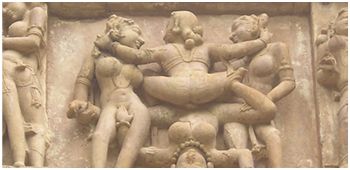
The last temple among the Southern Group of Temples of Khajuraho Dulhadev Temple lies to the south of Ghantai temple. Built in the year 1130 AD, the lovely shrine is a classic example of Chandela art and architecture. Dedicated to Lord Shiva, this is a small five chambered shrine, with a closed hall. The ceiling are decorated with the apsaras and other ornamented sculptures. Images of Shiva and his wife, Parvati, richly decorated with intricately carved jewellery are very striking. Though this temple lacks the charm and magic of other western group temples, its location on the banks of the pretty Khudar stream makes it a lovely shrine.
Ghantai Temple
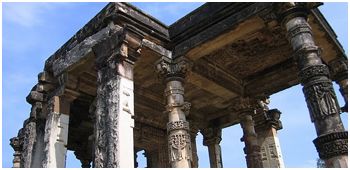
Built in between the years 950 and 1050 AD, Ghantai temple is one among the three famous Jain Temples found in Khajuraho. Like other ancient temples, this fascinating shrine also is in ruins, yet, it provides a bit of its original charm. The walls of the temple is ornamented by marvelous a fresco which depicts the 16 dream of Mahavir's mother, and a multi-armed Jain goddess hovering on a winged Garuda. One of the major Jain temple, Ghantai temple has played a significant role in the development of Jainism in India.
Kandariya Mahadev Temple
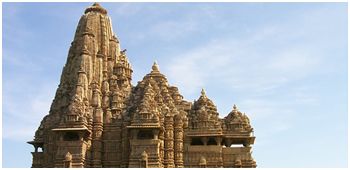
The most awesome and the largest temple in Khajuraho, Kandariya Mahadev Temple is built in around 1025–1050 AD. A typical sandstone structure, the temple is dedicated to Shiva with a linga at the center of the Garbha Griha. The elaborately engraved main shrine is bejeweled with more than 800 images, of which most of them are three feet high. The temple architecture consists of ardhamandapa, a mahamandapa supported with pillars, the garba griha and the pradakshina. The tower of the temple is about 100 ft high. The platform of the temple, which is decorated with sculptures of beautiful women in a variety of postures is really stunning. The southern and northern portions of this shrine depict the most erotic sculptures. The most elegant and famous temple also houses some of the fantastically ornate frescos on its wall, which speaks out the artistic grandeur of the bygone days.
Lakshmi Temple
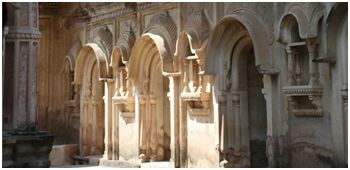
Khajuraho, a small town in madhya-pradesh is famed for its temples with wonderful sculptures. It is believed that there were 85 temples in the regions, out of which 25 exist at present. Lakhmi temple, dedicated to goddess Lakshmi, the Hindu deity of wealth, belongs to the Western Group of temples. A comparatively smaller shrine, this temple depicts moderate sculptures. The images of two guards supporting the pillar posts in front of the sanctum sanctorum are quite remarkable. A number of images of gods and goddesses enshrine the walls of this fascinating shrine. The temples of Kahjuraho have been included in the World Heritage List for their outstanding architecture and artistic value.
Jain Museum
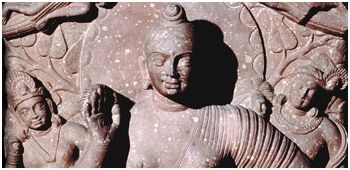
This museum houses more than hundred Jain sculptures and was inaugurated in the year 1987. Located with in the Jain Temple Complex, this circular building is also known as Sahu Shantiprasad Jain Kala Sangrahalaya. Jain Museum holds a modern circular gallery filled with statues of 24 tirthankars, along with sculptures of yakshis and other figures of Jains, which makes ones visit to the museum a worthy one. At the entrance of the museum there is two ornamented ‘Makara Toranas’ arranged on both sides of the steps definitely will win ones hearts. Jain Museum is open daily 8 am - 5 pm, except on Sundays.
State Museum of Tribal and Folk Art

Placed within Chandela Cultural Complex in Khajuraho, State Museum of Tribal and Folk Art symbolize the best of Indian civilization and custom and its fusion with foreign cultures that came through trade and incursion. A fine assemblage of masterpieces of tribal and folk art and artifacts from all over madhya-pradesh is exhibited at the Chandela Cultural Complex. The artifacts put on display gives a deep insight about the custom and rituals of the tribal people. The museum flaunts more than 500 variety articles made from woodcraft, terracotta, jewelry, tattoos, masks, metal craft and tribal and folk paintings. The Museum functions between 12 noon to 8 pm, on all days, except Mondays and Government Holidays.
Archaeological Museum

Khajuraho is largely acclaimed for its celebrated group of medieval temples embellished with awe-inspiring sculptures. In 1910, W.A. Jardine, an innovative local officer of the British government collected the loose sculptures and architectural members of the ruined temples of Khajuraho and preserved it in an enclosure built adjoining to the Matangeshwar Temple. Till 1952, this collection was known as Jardine Museum and then it was taken over by the Archaeological Survey of India. Now this open-air museum is used for collection of reserves wherein the public entry is prohibited. The present Archaeological Museum was set up in the year 1967, and it displays representative collection from the reserve museum. The Brahmanical, Jaina, and Buddhist faiths displayed in the five galleries of the new museum are conspicuous and arrest ones attention.
Light and Sound show
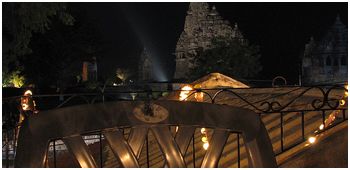
The Light and Sound show on the Western Group of temples complex the reminds the life and times of the great Chandela Kings and mark out the story of the exclusive temples from the 10th Century to the present day. The 50-minute fascinating show is held in every evening and it runs in Hindi and in English. Amitabh Bachchan, biggest of Bollywood stars, narrates the story of the magnificient temples and his majestic voice attributes a special effect to the show. The tourism department organizes the show, which is not only entertaining but also very informative. The first show is in English that starts at 6.30 pm and the second show is scheduled at 7.30 pm in Hindi. The entry fee for domestic and foreign tourists differs by a slight margin..